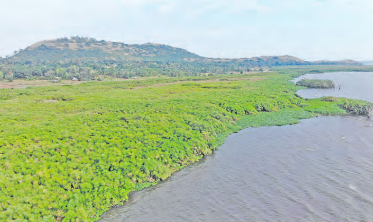
From a distance, the lush green colour of Yala Swamp is breathtaking and gives once-in-a-lifetime experience to first time visitors.
The swamp, nestled between Lake Victoria and the winding Yala and Nzoia rivers, is a natural treasure of immense ecological and cultural importance.
For years, the swamp has been a home to a rich variety of wildlife and provides essential resources for local communities.
Despite what this gem has to offer in terms of unrivalled beauty as well as the ecological service it has offered to the community, its state continues to deteriorate at an alarming rate.
Among the challenges facing the swamp include agricultural expansion, land grabbing, mining pollution and papyrus habitat destruction.
“The swamp plays a critical role in our lives,” Ayiro Lwala, a resident of Yimbo, says with despair dotted across his face.
Located on the northeastern shore of Lake Victoria, Yala Swamp is the largest papyrus wetland in Kenya and is crucial to the lake’s survival.
“It provides us with food, water, and materials for shelter.”
The swamp, according to experts, is a vital sanctuary for an incredible array of wildlife, including the endangered cichlid fish, the elusive sitatunga antelope and vast flocks of waterbirds, migratory birds.
Under threat are also papyrus species such as the papyrus gonolek and the papyrus yellow warbler.
Lwala says the conversion of the swamp for agricultural use and other human activities has degraded large parts of it.
In 2022, the National Land Commission approved the allocation of 6,764 hectare of Yala Swamp to Lake Agro Limited to establish a sugarcane plantation.
The move disappointed the local community who saw the move as a major blow to the swamp. Local communities protested the controversial allocation and went to court to object to it.
To the local communities, Yala Swamp is more than just a wetland – it is a lifeline. The swamp supports more than 250,000 people with crucial ecological services.
It filters the water of rivers flowing into the lake, trapping silt and agrochemicals. Residents depend on it for clean water, fishing, papyrus for thatching and irrigation during droughts.
The swamp is also an important carbon sink that contributes to global climate regulation.
Yala Swamp is a vital resource for a diverse range of wildlife, making it one of Kenya’s most significant ecosystems. It shelters two endangered Cichlid fish that are extinct in Lake Victoria.
The swamp also represents one of the few remaining habitats for the Sitatunga, a rare swamp-dwelling antelope. It is recognised as both a Key Biodiversity Area and an Important Bird Area.
Without appropriate protection, however, this rich biodiversity remains at risk. Its designation as a Ramsar site – a wetland of international importance – would provide the essential framework to safeguard its wildlife and ensure its future survival.
This global recognition would promote Yala Swamp’s conservation and ensure the sustainable use of its resources.
The communities believe that the swamp’s designation as a Ramsar Site would provide a framework for its sustainable management, balancing conservation with their needs.











